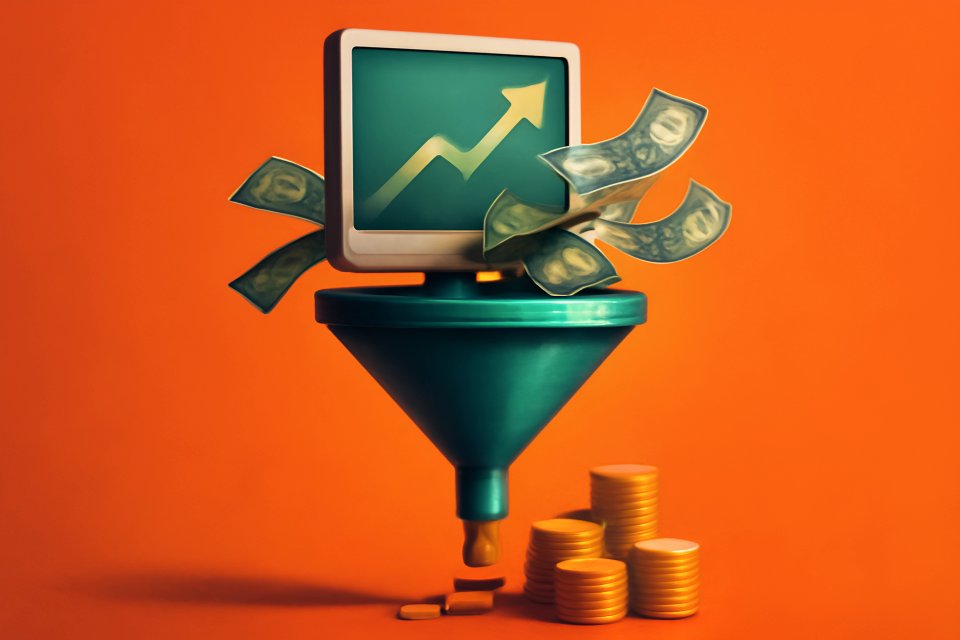
That blue light from the laptop screen is burning into your retinas again. It’s past midnight, the coffee has gone cold, and your income for the day is directly tied to how many more hours you can force your tired mind to work. Does this sound familiar? You’re a digital entrepreneur, a creator, a builder—but you’re also chained to the clock, trading your precious time for every single dollar.
Now, imagine a different morning. You wake up not to an alarm, but to the gentle ping of notifications on your phone: Sale! Sale! Sale!. While you were dreaming, an asset you built months ago was working for you, generating revenue, and buying back your freedom. This isn't a fantasy; it's the promise of passive income, but it comes with a critical dose of reality. Forget the myth of "magic money." True passive income is about front-loading the work to build a system that pays you back, again and again, with minimal ongoing effort.
In this in-depth guide, we'll move beyond the hype and explore actionable passive income strategies for digital entrepreneurs. We won't sell you a dream; we'll give you a blueprint. We'll compare the most popular methods, share insights from those already succeeding, and give you the tools to start building your own automated passive income ideas today.
The "Passive" Myth: Why It's Really About Building Systems, Not Magic Money
Let's get one thing straight: the term "passive" can be misleading. The internet is littered with gurus promising effortless wealth, but the truth is far more strategic and, frankly, more empowering. As one Shopify guide on passive income realities points out, true passivity is a myth; significant upfront work and periodic maintenance are unavoidable. The goal isn't to do nothing; it's to build something that works for you.
Think of it less like a lottery ticket and more like planting an orchard. You don't just toss seeds on the ground and expect fruit. You must first invest your time and energy to prepare the soil, plant the saplings, and water them diligently. Only after that initial, intense period of labor does the orchard begin to produce fruit year after year with only minimal upkeep. This is the core concept of front-loading your effort.
This reframes the entire conversation from a get-rich-quick scheme to a legitimate business strategy. You are investing your most valuable resources—time, expertise, or capital—to create a durable asset. Whether it's an online course, a piece of software, or a library of content, you are building a revenue-generating machine. This approach aligns with the IRS's technical definition of passive income, which often involves earnings from businesses where you don't "materially participate" on a day-to-day basis.
The Digital Entrepreneur's Toolkit: 7 Viable Passive Income Strategies
So, you're ready to build your orchard. But which seeds should you plant? The digital landscape offers a fertile ground of opportunities, each suited for different skills and ambitions. Let's explore the most viable paths for today's entrepreneur.
Strategy 1: Affiliate Marketing
Imagine being the most trusted friend in your circle, the one everyone asks for recommendations. Now, imagine getting paid every time your recommendation leads to a sale. That's the essence of affiliate marketing. You earn a commission by promoting products or services you genuinely believe in. This isn't about spamming links; it's about building an audience that trusts your judgment.
The upfront effort involves creating valuable content—a blog, a YouTube channel, a newsletter—that attracts and helps your target audience. According to Neil Patel, less than 10% of affiliates generate 90% of the industry's revenue, proving that expertise and trust are paramount. The key is authentic promotion. Pat Flynn’s philosophy of "involved affiliate marketing" champions only promoting products you personally use and trust, a strategy that builds deep credibility and boosts conversions.
Meet Sarah, a productivity blogger who earns over $1,500/month passively by recommending project management software she uses daily. Her secret? She doesn't just drop a link; she creates in-depth tutorials and case studies showing exactly how the tool solved her problems. For a deeper look into this model, our step-by-step guide to scaling affiliate income provides a complete roadmap.
Strategy 2: Creating and Selling Digital Products
What if the product you're selling is your own creation? Digital products—like ebooks, templates, presets, or planners—are one of the most powerful digital passive income streams. You create the asset once, and you can sell it an infinite number of times with nearly zero overhead. The profit margins are incredibly high because there's no inventory to manage and no shipping to worry about.
The work is concentrated in the creation phase: identifying a painful problem for your audience and designing an elegant, effective solution. This could be anything from a set of Canva templates for overwhelmed small business owners to a comprehensive ebook on a niche skill. According to Shopify, top digital sellers on platforms like Whop can average $2,000/month, demonstrating the immense potential.
Consider Alex, a graphic designer who noticed his clients constantly struggled with organizing their projects. He turned his custom Notion templates into a digital product and now generates over $20,000 a year. He solved one specific, painful problem, and the market rewarded him for it. The best part? Tools like Gumroad and SendOwl automate the entire sales and delivery process.
Strategy 3: Launching an Online Course
If a digital product solves a specific problem, an online course offers a complete transformation. This is where you package your deepest expertise into a structured, step-by-step learning experience. It's one of the most labor-intensive strategies upfront, requiring curriculum planning, video recording, and creating supporting materials. However, the payoff can be monumental.
The potential for earning passive income online through courses is staggering. Teachable reports that creators like Pat Flynn have earned as much as $169,000 from just two courses. The most successful courses are hyper-specific, targeting underserved niches like "watercolor techniques for beginners" or "Python for data analysis."
While the income is largely passive after launch, it's more accurately described as semi-passive. You may need to update content periodically or manage a student community to keep the course relevant and valuable. Platforms like Teachable, Thinkific, and the all-in-one platform Podia handle the heavy lifting of hosting, payments, and content delivery, freeing you to focus on what you do best: teaching.
Strategy 4: Print-on-Demand (POD)
Are you an artist, a designer, or just someone with a knack for witty slogans? Print-on-demand (POD) allows you to monetize your creativity without ever touching a roll of packing tape or investing a dime in inventory. You simply create designs and upload them to products like t-shirts, mugs, and posters. When a customer places an order, a third-party company like Printful or Printify prints, packs, and ships the product directly to them.
The upfront effort is relatively low, focused entirely on design creation and setting up your online store on a platform like Etsy or Shopify. Your passive potential is directly tied to the uniqueness and appeal of your designs. The most successful POD sellers tap into niche trends and subcultures, creating products that feel personal and exclusive.
This model is a fantastic entry point into e-commerce because the financial risk is virtually zero. You only pay for the product after you've already made a sale. For those intrigued by this hands-off business model, our guide on unlocking passive income with print-on-demand offers a complete walkthrough.
Strategy 5: Ad & Sponsorship Revenue
If you've already done the hard work of building a high-traffic blog, YouTube channel, or podcast, you're sitting on a digital asset that can be monetized passively. Display advertising and sponsorships allow you to earn revenue from the audience you've already cultivated. This isn't about creating something new to sell; it's about leveraging the attention you've already captured.
Premium ad networks like Mediavine and AdThrive offer a largely hands-off way to generate significant income. For example, travel blogger Kristin Addis earns over $10,000 per month from Mediavine ads on her site. The network handles all the ad placements and optimization, allowing you to focus on creating the great content that brought you traffic in the first place.
The upfront effort here is immense, as these networks have high traffic minimums (e.g., 50,000 monthly sessions for Mediavine). However, once you're accepted, the income is one of the most passive forms available. Sponsorships require a bit more active negotiation but can provide large, lump-sum payments for pre-roll ads or dedicated content.
Strategy 6: Building a Micro-SaaS Product
For the tech-savvy entrepreneur, building a Micro-SaaS (Software-as-a-Service) product represents the pinnacle of scalable passive income. This involves creating a small, focused software tool that solves a very specific problem for a niche audience, typically on a recurring subscription basis. Think of a browser extension that automates a tedious task or a simple analytics tool for a specific platform.
The upfront effort is the highest of any strategy on this list, requiring either deep technical skills or the capital to hire developers. However, the reward is a truly automated, recurring revenue stream. As reported by Indie Hackers, it's not uncommon for solo founders to build tools that generate $5,000/month or more with minimal ongoing maintenance.
We spoke with the founder of a simple WordPress plugin who identified a gap in the market for freelance writers. He built a tool to help them track their pitches and now generates over $5,000 a month in recurring revenue. His success came from solving a problem he knew intimately, a key lesson for any aspiring Micro-SaaS founder.
Strategy 7: Stock Media Royalties
If you're a photographer, videographer, or musician, your hard drive is likely filled with potential passive income assets. By uploading your high-quality photos, video clips, or audio tracks to stock marketplaces like Adobe Stock or Shutterstock, you can earn a royalty every time someone downloads your work.
The upfront effort involves curating, editing, and uploading a large portfolio of assets. Success in this space is a numbers game. While a single photo might only earn you cents per download, a portfolio of thousands of high-demand assets can generate a steady, reliable income stream. According to Shutterstock, contributors can earn a commission of 15-40% per download.
This is a long-term play that requires patience and a focus on volume. The most successful contributors research commercial trends and create content that businesses are actively searching for. Once uploaded, however, a single photo can continue earning you money for years to come with zero additional effort.
Strategic Comparison: Which Passive Income Stream is Right for You?
Choosing where to invest your precious time and energy is the most critical decision you'll make. Not all passive income streams are created equal, and the right choice for you depends entirely on your unique blend of skills, capital, and time. Let's compare these strategies head-to-head to help you find your perfect fit.
| Strategy | Upfront Cost | Time Investment | Scalability | Required Skill |
|---|---|---|---|---|
| Affiliate Marketing | Low | Medium | High | Content/SEO |
| Digital Products | Low | Medium | Very High | Design/Expertise |
| Online Courses | Medium | High | High | Teaching/Expertise |
| Print-on-Demand | Very Low | Low | Medium | Design |
| Micro-SaaS | High | Very High | Very High | Technical/Dev |
As the table reveals, there's a clear trade-off between accessibility and potential. If you're low on capital but rich in expertise, creating and selling digital products offers the highest scalability with a moderate time investment. If you have strong design skills but are short on time, print-on-demand is an excellent, low-risk entry point. For those with technical prowess and a vision, a Micro-SaaS product offers the ultimate prize, but demands the most significant upfront commitment.
Building Your Automated Engine: The Tools That Make It Passive
The dream of "earning while you sleep" isn't powered by magic; it's powered by technology. The "passive" part of the equation is made possible by a stack of digital tools that automate the most time-consuming parts of running an online business. Building this automated engine is the final step in creating your income-generating asset.
For sales and delivery, platforms like Gumroad or the creator-friendly platform Podia are essential. They handle payment processing, tax collection, and the automatic delivery of your digital goods the moment a purchase is made. This is the core of your automated system, ensuring a seamless customer experience without you lifting a finger.
For marketing, email automation is your most powerful ally. Tools like ConvertKit or MailerLite allow you to build email autoresponders that nurture new leads, build trust, and sell your products on autopilot. As Dorie Clark's success with automated email funnels demonstrates, you can create hands-off revenue by turning your email list into a sales machine. For a full breakdown, explore our guide to the essential digital tools for solopreneurs.
Conclusion: Stop Trading Time for Money—Start Building Assets
You started this journey as a digital entrepreneur to gain freedom, not to build a more demanding prison for yourself. The constant hustle, the feeling that the business stops when you do—that ends now. Earning passive income online is not just a possibility; it's a strategic imperative for anyone who wants to build a sustainable and fulfilling career in the digital age.
We've demystified the process, moving beyond the hype to show you that this is an achievable goal for anyone willing to do the upfront work. It's not about luck or magic. It's about making a smart, strategic decision to invest in yourself and build an asset that will serve you for years to come. It's about finally earning smarter, not just harder.
You have the strategies. You have the tools. The only question left is: what's the first passive income asset you're inspired to build? Share your idea in the comments below—we'd love to cheer you on!
FAQ Section
Q1: What is the easiest passive income stream for a beginner?
For most beginners, Print-on-Demand (POD) or Affiliate Marketing are the most accessible entry points. POD requires minimal financial investment and focuses on a single skill (design), while affiliate marketing allows you to leverage content creation skills without needing to build your own product. Both are detailed in our guide to proven strategies for beginners.
Q2: How much can you realistically earn from these digital passive income streams?
Earnings vary wildly based on the strategy, your niche, and your execution. Some creators earn a few hundred dollars a month, which can be life-changing "dinner money," while others, like top course creators or ad revenue earners, generate five or six figures monthly. Data shows that while only 20% of Americans earn any passive income, dedicated digital entrepreneurs can far exceed the typical sub-$5,000/year average by building scalable digital assets.
Q3: Do I need a large audience to start earning passive income?
No, you don't need a massive audience, but you do need the right audience. A small, highly engaged group of 1,000 true fans who trust you is far more valuable than 100,000 passive followers. Strategies like selling niche digital products or building a Micro-SaaS can be incredibly profitable with a very small, targeted customer base. The key is to solve a specific problem for a specific group of people.

















